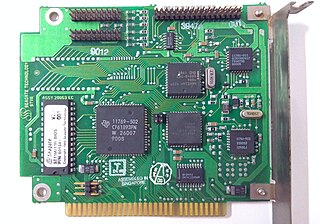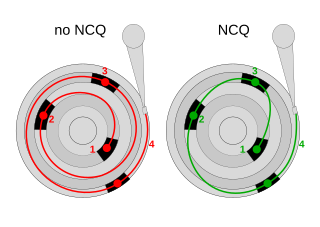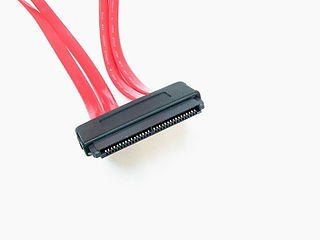Related Research Articles

Parallel ATA (PATA), originally AT Attachment, also known as ATA or IDE is standard interface designed for IBM PC-compatible computers. It was first developed by Western Digital and Compaq in 1986 for compatible hard drives and CD or DVD drives. The connection is used for storage devices such as hard disk drives, floppy disk drives, and optical disc drives in computers.

In computer architecture, a bus is a communication system that transfers data between components inside a computer, or between computers. This expression covers all related hardware components and software, including communication protocols.

Industry Standard Architecture (ISA) is the 16-bit internal bus of IBM PC/AT and similar computers based on the Intel 80286 and its immediate successors during the 1980s. The bus was (largely) backward compatible with the 8-bit bus of the 8088-based IBM PC, including the IBM PC/XT as well as IBM PC compatibles.

Small Computer System Interface is a set of standards for physically connecting and transferring data between computers and peripheral devices. The SCSI standards define commands, protocols, electrical, optical and logical interfaces. The SCSI standard defines command sets for specific peripheral device types; the presence of "unknown" as one of these types means that in theory it can be used as an interface to almost any device, but the standard is highly pragmatic and addressed toward commercial requirements. The initial Parallel SCSI was most commonly used for hard disk drives and tape drives, but it can connect a wide range of other devices, including scanners and CD drives, although not all controllers can handle all devices.
Direct memory access (DMA) is a feature of computer systems and allows certain hardware subsystems to access main system memory independently of the central processing unit (CPU).

Serial ATA is a computer bus interface that connects host bus adapters to mass storage devices such as hard disk drives, optical drives, and solid-state drives. Serial ATA succeeded the earlier Parallel ATA (PATA) standard to become the predominant interface for storage devices.

The disk controller is the controller circuit which enables the CPU to communicate with a hard disk, floppy disk or other kind of disk drive. It also provides an interface between the disk drive and the bus connecting it to the rest of the system.

In computer hardware, a host controller, host adapter, or host bus adapter (HBA), connects a computer system bus, which acts as the host system, to other network and storage devices. The terms are primarily used to refer to devices for connecting SCSI, Fibre Channel and SATA devices. Devices for connecting to IDE, Ethernet, FireWire, USB and other systems may also be called host adapters.
A disk array controller is a device that manages the physical disk drives and presents them to the computer as logical units. It almost always implements hardware RAID, thus it is sometimes referred to as RAID controller. It also often provides additional disk cache.

In computing, Native Command Queuing (NCQ) is an extension of the Serial ATA protocol allowing hard disk drives to internally optimize the order in which received read and write commands are executed. This can reduce the amount of unnecessary drive head movement, resulting in increased performance for workloads where multiple simultaneous read/write requests are outstanding, most often occurring in server-type applications.

In computing, Serial Attached SCSI (SAS) is a point-to-point serial protocol that moves data to and from computer-storage devices such as hard disk drives and tape drives. SAS replaces the older Parallel SCSI bus technology that first appeared in the mid-1980s. SAS, like its predecessor, uses the standard SCSI command set. SAS offers optional compatibility with Serial ATA (SATA), versions 2 and later. This allows the connection of SATA drives to most SAS backplanes or controllers. The reverse, connecting SAS drives to SATA backplanes, is not possible.
BIOS interrupt calls are a facility that operating systems and application programs use to invoke the facilities of the Basic Input/Output System software on IBM PC compatible computers. Traditionally, BIOS calls are mainly used by DOS programs and some other software such as boot loaders. BIOS runs in the real address mode of the x86 CPU, so programs that call BIOS either must also run in real mode or must switch from protected mode to real mode before calling BIOS and then switching back again. For this reason, modern operating systems that use the CPU in Protected mode or Long mode generally do not use the BIOS interrupt calls to support system functions, although they use the BIOS interrupt calls to probe and initialize hardware during booting. Real mode has the 1MB memory limitation, modern boot loaders use the unreal mode or protected mode to access up to 4GB memory.

QEMU is a free and open-source emulator. It emulates the machine's processor through dynamic binary translation and provides a set of different hardware and device models for the machine, enabling it to run a variety of guest operating systems. It can interoperate with Kernel-based Virtual Machine (KVM) to run virtual machines at near-native speed. QEMU can also do emulation for user-level processes, allowing applications compiled for one architecture to run on another.
A SCSI connector is used to connect computer parts that use a system called SCSI to communicate with each other. Generally, two connectors, designated male and female, plug together to form a connection which allows two components, such as a computer and a disk drive, to communicate with each other. SCSI connectors can be electrical connectors or optical connectors. There have been a large variety of SCSI connectors in use at one time or another in the computer industry. Twenty-five years of evolution and three major revisions of the standards resulted in requirements for Parallel SCSI connectors that could handle an 8, 16 or 32 bit wide bus running at 5, 10 or 20 megatransfer/s, with conventional or differential signaling. Serial SCSI added another three transport types, each with one or more connector types. Manufacturers have frequently chosen connectors based on factors of size, cost, or convenience at the expense of compatibility.

Parallel SCSI is the earliest of the interface implementations in the SCSI family. SPI is a parallel bus; there is one set of electrical connections stretching from one end of the SCSI bus to the other. A SCSI device attaches to the bus but does not interrupt it. Both ends of the bus must be terminated.
In computer science, a command queue is a queue for enabling the delay of command execution, either in order of priority, on a first-in first-out basis, or in any order that serves the current purpose. Instead of waiting for each command to be executed before sending the next one, the program just puts all the commands in the queue and goes on doing other things while the queue is processed by the operating system.
sync is a standard system call in the Unix operating system, which commits all data in the kernel filesystem to non-volatile storage buffers, i.e., data which has been scheduled for writing via low-level I/O system calls. Higher-level I/O layers such as stdio may maintain separate buffers of their own.

In computer storage, disk buffer is the embedded memory in a hard disk drive (HDD) acting as a buffer between the rest of the computer and the physical hard disk platter that is used for storage. Modern hard disk drives come with 8 to 256 MiB of such memory, and solid-state drives come with up to 4 GB of cache memory.

A storage area network (SAN) or storage network is a computer network which provides access to consolidated, block-level data storage. SANs are primarily used to access data storage devices, such as disk arrays and tape libraries from servers so that the devices appear to the operating system as direct-attached storage. A SAN typically is a dedicated network of storage devices not accessible through the local area network (LAN).
Hard disk drives are accessed over one of a number of bus types, including parallel ATA, Serial ATA (SATA), SCSI, Serial Attached SCSI (SAS), and Fibre Channel. Bridge circuitry is sometimes used to connect hard disk drives to buses with which they cannot communicate natively, such as IEEE 1394, USB, SCSI, NVMe and Thunderbolt.
References
- ↑ in the form of Parallel SCSI, Serial attached SCSI, and Fibre Channel drives
- 1 2 3 4 5 6 7 8 9 10 11 12 13 Dees, Brian (November–December 2005). "Native command queuing - advanced performance in desktop storage". IEEE Potentials. 24 (4): 4–7. doi:10.1109/MP.2005.1549750. S2CID 36264057.
- 1 2 3 4 5 6 "SCSI Architecture Model - 3 (SAM-3)" (PDF). Archived from the original (PDF) on 2012-03-17. Retrieved 2007-02-24.
- 1 2 "1532D: AT Attachment with Packet Interface - 7 Volume 1" (PDF). 1532D: AT Attachment with Packet Interface - 7. Retrieved 2007-01-02.